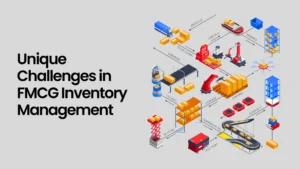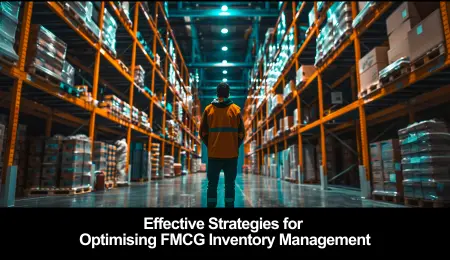Effective Strategies for Optimising FMCG Inventory Management
Inventory management refers to stock management in general. In the world of FMCG (Fast Moving Consumer) manufacturers, Inventory management plays a vital role in the success of FMCG business. The trend and demand for FMCG products change rapidly, leading to stock outs and excess stock. It is essential for FMCG manufacturers to learn about effective FMCG inventory management to avoid lost sales and financial losses.
This is where the success of FMCG lies. Producing high quality products and offering them at an optimal price are not enough to be successful in the fast-paced world of the FMCG market. It is imperative to make your products available on market or store when and where the customers need them.
Imagine that you are running a manufacturing company producing FMCG products, like food, snacks, beverages, and household essentials. If your products are not available in the market when the demand is on peak, you will definitely end up with lost sales. The lost presence of your product during demand will reduce your brand’s reputation and your product will be left far behind amid all other brands in the competition. Let’s dive into the inventory management for FMCG distributors in this blog.

Unique Challenges in FMCG Inventory Management:
FMCG products reach the selling store after going through many stages right from the manufacturing place. This supply chain includes various stakeholders. If a lag occurs at one place in the supply chain, it will affect the movement of the products in reaching the store. Also ineffective management at any point in the supply chain results in high costs and potential losses. In this section, let’s discuss the unique challenges involved in the FMCG inventory management and FMCG distribution supply chain management.
Demand Fluctuations:
The demand for the FMCG products fluctuates rapidly due to various factors. For example, the demand for ice cream can increase unexpectedly due to a surge in temperature. The demand for ice cream can also suddenly go down for days due to heavy rains in the summer season continuously for several days. So demand for your product in the market faces ups and downs depending on various factors.
The factors typically contribute to the demand fluctuations are seasonal requirements, market trends, changes in consumers’ preferences, and promotional activities. Seasonal changes and unexpected change in regular seasons highly influence the demand for certain FMCG products. The change of lifestyles in individuals and society affects products’ needs among consumers. Trends sprout out in unexpected manner anytime, that result in high demand for certain products in the market.
As these factors create fluctuations in the demand of FMCG products, FMCG manufacturers face stock out and excess stock challenges. A sudden hike in the demand results in stock out, lost sales and losing brand’s reputation in the market. A sudden fall in the demand results in excess stock, possessing increased holding costs, the risk of becoming outdated and expired.
Short Shelf Life:
Most of the FMCG products fall under the category of perishable goods and come with a limited shelf life. So it is important to place them in stores after production as soon as possible and more importantly sell them out in good condition before they expire. It is a thrilling experience for FMCG stakeholders to sell these products with a short shelf life.
A proper planning, timely execution, precautionary steps to prevent spoilage, and keen attention on storing methods to preserve these products’ quality and safety are essential in handling these kinds of FMCG products. If you miss anything, you will encounter a financial loss for sure due to spoilage, expiration, and reduced quality.
So it is important to understand that the short shelf life products require specific storage, handling methods, precise control and continuous monitoring. Ensuring all these will save you from potential losses in your FMCG business model.
Complex Supply Chain:
The supply chain of any product includes various stakeholders. A product travels through different stages and different people from the manufacturing hub to the selling store. Taking care of your products properly in all these multiple stages is in the hands of many people. So everyone in the supply chain has to be responsible in handling the products. If anyone fails to do it, you as a manufacturer have to bear the burden.
That’s why it is essential to work collaboratively to ensure everything is going smoothly all through the process. For this, effective communication channels have to be established among manufacturers, suppliers, distributors, and store keepers. The cooperation and synchronization in the process is important to make it possible.
The lack of visibility to stock levels, transportation status in the FMCG process flow, and production capacity leaves these stakeholders indecisive and unable to plan accordingly during any unexpected and change in situations. These gaps have to be filled using effective strategies to plan and take decisions accordingly.
Key Strategies for Effective FMCG Inventory Management:
FMCG companies are in a need to devise key strategies to face all the challenges associated with FMCG products handling and market situations. Experience and observations from the application of various methods in the past can provide insights on key strategies to implement for effective inventory management.
Let’s dive more into the effective strategies to apply in your FMCG business in order to ensure profitability. These key strategies will eliminate the risks involved due to demand fluctuations, short shelf life, and complex supply chain.
1. Demand forecasting:
Demand fluctuations have to be forecasted effectively to avoid stock out and excess stock issues. Demand forecasting can be performed with historical sales data, observing market trends, and receiving feedback from consumers. These data will help in forecasting demand fluctuations as accurately as possible.
It is highly recommended to work together with sales and marketing teams to collect all the necessary information to predict change in demand. The digital world offers many automated inventory solutions for FMCG businesses that make use of cutting-edge technologies such as advanced analytics tools to analyze the collected data efficiently. Also please utilize predictive modeling techniques available in the field.
2. Flexible Production:
FMCG companies must empower themselves with flexible production methods to adjust and act on any situations without strain, especially during demand fluctuations. The flexibility can be achieved by implementing manufacturing practices such as modular production lines, training work forces in every part of the manufacturing. Establishing such an inventory control business plan helps in increasing or to scale down production as per demand.
3. Safety Stock:
Maintaining a safety stock definitely will save you from prompt production processes and give you a relief of acting promptly without any strain. Safety stock is a solution to face the challenge of sudden increase in demand and ensures the continued flow in the supply chain.
4. Just-in-Time Inventory:
Just-in-Time inventory practice works if you have reliable supplier relationships, optimized production schedules, and sturdy inventory management systems. As you act only upon demand in the JIT (Just-in-Time) inventory method, it minimizes holding costs and eliminates the risk of products becoming outdated.
5. ABC Analysis:
FMCG products are classified into A, B, C categories as follows:
A: High-value, high-demand items.
B: Moderate-value, moderate-demand items.
C: Low-value, low-demand items.
Focus on A category items as they bring more revenue and profitability by allocating more resources and attention to them while streamlining a standard approach to B and C category FMCG products.
Best FMCG Inventory Management Techniques:
As we discussed, implementing best inventory management techniques can make your FMCG business run efficiently. Moreover, these techniques will also keep you ahead of the curve in front of your competitors.
Batch tracking:
A batch of products is provided with an identifier or batch number in the FMCG manufacturing process. This batch number includes information such as manufacturing date, expiry date and manufacturing location. It facilitates effective tracking all through the supply chain stages from production to sales.
First-In-First-Out (FIFO):
Please ensure selling the old stock at first before newer stock by sticking to FIFO principles. So the risk of expiration of old stock can be reduced.
Economic Order Quantity (EOQ):
Economic order quantity is a mathematical formula. It helps in calculating optimal order quantity, reducing total inventory cost including inventory order costs and inventory holding costs. This method ensures inventory optimization for FMCG distribution.
Role of Technology in FMCG Inventory Management:
The cutting-edge technologies ease the friction for FMCG inventory management, providing increased tracking facilities, database maintenance at one place accessible for all the decision makers, and analytics tools.
Inventory Management Software:
Inventory management software designed to fulfill the needs of any manufacturing companies greatly helps in simplifying the processes involved in the inventory management. These platforms come with features including real-time tracking, demand forecasting, automated restoration of stock, and integration with other business systems for better streamlined operations.
RFID Technology:
RFID (Radio Frequency Identification) tags enables effective tracking of inventory at every stage in the complex supply chain and empowers stakeholders to make decisions effectively provided by the better real-time visibility into stock levels and location.
Conclusion:
Proactive inventory management is essential to mitigate the challenges involved in the fast-paced and fast changing FMCG market. FMCG companies can thrive and maintain a sustainable growth in the field by implementing best practices for FMCG inventory management methods & effective FMCG warehouse management, incorporating available technology options, paying a keen attention on improvements and innovation.
Mastering inventory management plays a vital role in staying ahead of the game in the dynamic world of FMCG products. Please ensure implementing best inventory management practices to fulfill customers’ expectations and add value to your customers, stakeholders with your excellent operational methods.


Leave a Comment